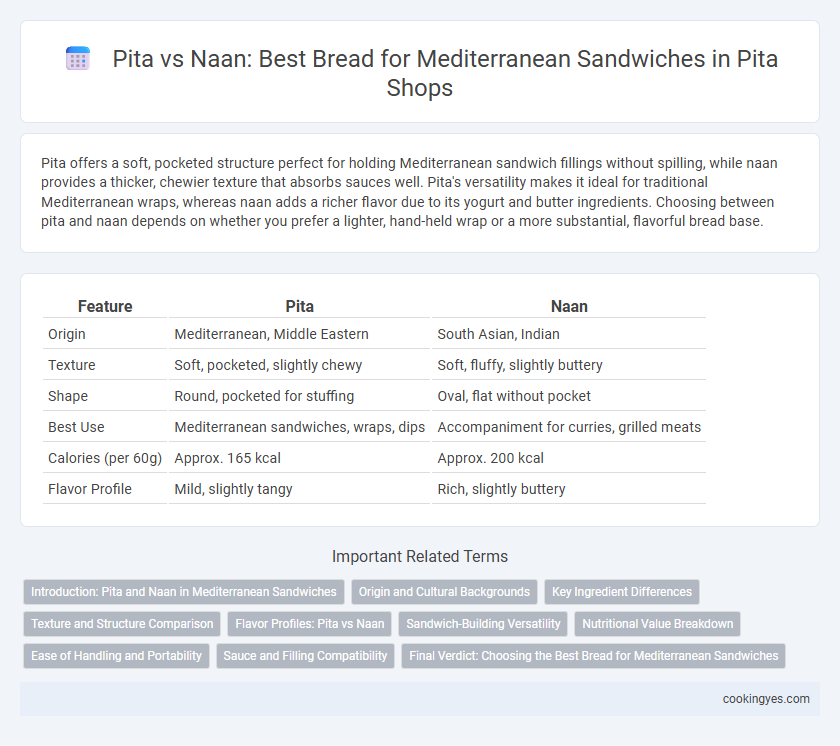Pita offers a soft, pocketed structure perfect for holding Mediterranean sandwich fillings without spilling, while naan provides a thicker, chewier texture that absorbs sauces well. Pita's versatility makes it ideal for traditional Mediterranean wraps, whereas naan adds a richer flavor due to its yogurt and butter ingredients. Choosing between pita and naan depends on whether you prefer a lighter, hand-held wrap or a more substantial, flavorful bread base.
Table of Comparison
| Feature | Pita | Naan |
|---|---|---|
| Origin | Mediterranean, Middle Eastern | South Asian, Indian |
| Texture | Soft, pocketed, slightly chewy | Soft, fluffy, slightly buttery |
| Shape | Round, pocketed for stuffing | Oval, flat without pocket |
| Best Use | Mediterranean sandwiches, wraps, dips | Accompaniment for curries, grilled meats |
| Calories (per 60g) | Approx. 165 kcal | Approx. 200 kcal |
| Flavor Profile | Mild, slightly tangy | Rich, slightly buttery |
Introduction: Pita and Naan in Mediterranean Sandwiches
Pita and naan serve as popular bread choices for Mediterranean sandwiches, each bringing unique textures and flavors that complement the fillings. Pita, a soft, pocketed flatbread, is ideal for holding a variety of ingredients like falafel, shawarma, and fresh vegetables. Naan offers a thicker, chewier profile often infused with garlic or butter, enhancing sandwiches with rich, savory notes.
Origin and Cultural Backgrounds
Pita originates from the Eastern Mediterranean, particularly Greece and the Levant, where it serves as a traditional staple bread for sandwiches and dips, characterized by its pocket-like structure. Naan, with roots in South Asia and Central Asia, is a leavened flatbread traditionally cooked in a tandoor oven, often richer and thicker without the pocket feature. The cultural background of pita is deeply tied to Mediterranean diets emphasizing fresh vegetables and grilled meats, while naan reflects South Asian culinary traditions, commonly accompanying curries and rich sauces.
Key Ingredient Differences
Pita and naan differ primarily in their key ingredients, influencing their texture and flavor in Mediterranean sandwiches. Pita typically uses simple ingredients like flour, water, yeast, and salt, creating a light, pocketed bread ideal for stuffing. Naan incorporates yogurt or milk and sometimes eggs, resulting in a softer, richer texture with a slightly tangier taste that complements various Mediterranean fillings.
Texture and Structure Comparison
Pita bread features a pocket-like structure that crisply holds Mediterranean sandwich fillings without sogginess, making it ideal for layered ingredients like falafel and tabbouleh. Naan offers a softer, chewier texture with a denser crumb, which can absorb sauces but may not maintain the sandwich's form as effectively. The pocket integrity and lightweight airiness of pita provide a distinct advantage in creating well-structured, easy-to-handle Mediterranean sandwiches.
Flavor Profiles: Pita vs Naan
Pita offers a mild, slightly tangy flavor with a light, airy texture that complements the fresh and vibrant ingredients typical in Mediterranean sandwiches. Naan provides a richer, buttery taste with a soft, chewy consistency, often infused with garlic or herbs, adding depth to the sandwich experience. The choice between pita and naan significantly impacts the overall flavor profile, balancing between subtlety and richness.
Sandwich-Building Versatility
Pita offers superior sandwich-building versatility compared to naan, featuring a pocket that securely holds various Mediterranean fillings like falafel, gyro meat, and fresh vegetables without spilling. Its sturdy yet soft texture supports both heavy and light ingredients, making it ideal for layered sandwiches and wraps. In contrast, naan's flat, thicker consistency lacks a built-in pocket, limiting its capacity to contain fillings and making it less practical for portable Mediterranean sandwiches.
Nutritional Value Breakdown
Pita bread contains approximately 165 calories, 33 grams of carbohydrates, 6 grams of protein, and 1 gram of fat per 60-gram serving, making it a lower-calorie and lower-fat option compared to naan. Naan bread averages around 260 calories, 45 grams of carbohydrates, 9 grams of protein, and 6 grams of fat per 100-gram serving, largely due to its higher fat content from butter or ghee. For Mediterranean sandwiches, pita offers a lighter nutritional profile conducive to lower calorie intake and reduced fat consumption while still providing essential carbohydrates and proteins.
Ease of Handling and Portability
Pita bread features a pocket-like structure that easily holds Mediterranean sandwich fillings, making it highly convenient for handling and eating on the go. Its firm yet soft texture prevents fillings from spilling, enhancing portability compared to naan, which lacks a natural pocket and is often softer and more flexible. The compact shape of pita ensures minimal mess and maximum ease when carrying sandwiches during travel or outdoor meals.
Sauce and Filling Compatibility
Pita bread's pocket structure enhances sauce retention, preventing spills and ensuring even distribution throughout Mediterranean sandwiches. Its slightly chewy texture complements moist fillings such as hummus, tzatziki, and marinated vegetables, creating balanced flavors and textures. Compared to naan, which is denser and lacks a pocket, pita offers superior compatibility for saucy and layered Mediterranean sandwich fillings.
Final Verdict: Choosing the Best Bread for Mediterranean Sandwiches
Pita offers a versatile, pocketed structure ideal for holding Mediterranean sandwich fillings without spilling, making it a practical choice for gyro, falafel, and shawarma wraps. Naan provides a softer, thicker texture with a slightly buttery flavor that complements heavy, saucy ingredients but lacks the convenient pocket of pita. For authentic Mediterranean sandwiches, pita's balance of durability and lightness typically makes it the preferred bread, especially when ease of eating and ingredient containment are top priorities.
Pita vs Naan for Mediterranean sandwiches Infographic

 cookingyes.com
cookingyes.com